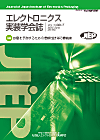Volume 14, Issue 7
Displaying 1-17 of 17 articles from this issue
- |<
- <
- 1
- >
- >|
Preface
-
Article type: Preface
2011 Volume 14 Issue 7 Pages P7
Published: November 01, 2011
Released on J-STAGE: March 07, 2012
Download PDF (565K)
Special Articles: Optical Interconnection—Expectations and Prospects
-
Article type: Special Articles / Optical Interconnection—Expectations and Prospects
2011 Volume 14 Issue 7 Pages 531
Published: November 01, 2011
Released on J-STAGE: March 07, 2012
Download PDF (516K) -
Article type: Special Articles / Optical Interconnection—Expectations and Prospects
2011 Volume 14 Issue 7 Pages 532-536
Published: November 01, 2011
Released on J-STAGE: March 07, 2012
Download PDF (1471K) -
Article type: Special Articles / Optical Interconnection—Expectations and Prospects
2011 Volume 14 Issue 7 Pages 537-541
Published: November 01, 2011
Released on J-STAGE: March 07, 2012
Download PDF (922K) -
Article type: Special Articles / Optical Interconnection—Expectations and Prospects
2011 Volume 14 Issue 7 Pages 542-546
Published: November 01, 2011
Released on J-STAGE: March 07, 2012
Download PDF (774K) -
Article type: Special Articles / Optical Interconnection—Expectations and Prospects
2011 Volume 14 Issue 7 Pages 547-549
Published: November 01, 2011
Released on J-STAGE: March 07, 2012
Download PDF (1206K) -
Article type: Special Articles / Optical Interconnection—Expectations and Prospects
2011 Volume 14 Issue 7 Pages 550-554
Published: November 01, 2011
Released on J-STAGE: March 07, 2012
Download PDF (1032K)
Technical Papers
-
Article type: Technical Papers
2011 Volume 14 Issue 7 Pages 555-565
Published: November 01, 2011
Released on J-STAGE: March 07, 2012
Download PDF (2699K) -
Article type: Technical Papers
2011 Volume 14 Issue 7 Pages 566-570
Published: November 01, 2011
Released on J-STAGE: March 07, 2012
Download PDF (2585K)
Tutorial Series – The Basic Concept, Standard Structures and Fabrication Technologies of Through Silicon Vias ④
-
Article type: Tutorial Series - The Basic Concept, Standard Structures and Fabrication Technologies of Through Silicon Vias ④
2011 Volume 14 Issue 7 Pages 571-577
Published: November 01, 2011
Released on J-STAGE: March 07, 2012
Download PDF (4225K)
Report
-
Article type: Report
2011 Volume 14 Issue 7 Pages 578
Published: November 01, 2011
Released on J-STAGE: March 07, 2012
Download PDF (876K)
-
2011 Volume 14 Issue 7 Pages 579-581
Published: November 01, 2011
Released on J-STAGE: March 07, 2012
Download PDF (997K) -
2011 Volume 14 Issue 7 Pages 582
Published: November 01, 2011
Released on J-STAGE: March 07, 2012
Download PDF (875K) -
2011 Volume 14 Issue 7 Pages 583-584
Published: November 01, 2011
Released on J-STAGE: March 07, 2012
Download PDF (691K) -
2011 Volume 14 Issue 7 Pages A71
Published: November 01, 2011
Released on J-STAGE: March 07, 2012
Download PDF (1490K) -
2011 Volume 14 Issue 7 Pages C71
Published: November 01, 2011
Released on J-STAGE: March 07, 2012
Download PDF (488K) -
2011 Volume 14 Issue 7 Pages C72
Published: November 01, 2011
Released on J-STAGE: March 07, 2012
Download PDF (491K)
- |<
- <
- 1
- >
- >|
